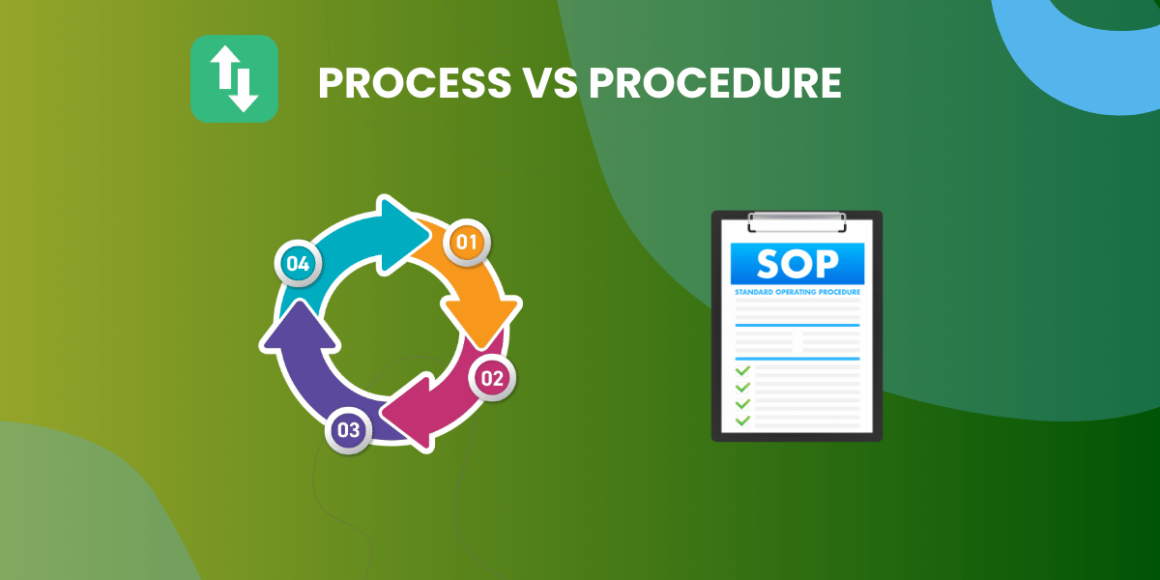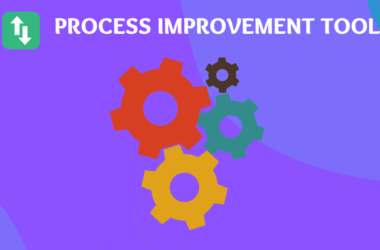Table of Contents Show
Understanding the difference between “process vs procedure” is essential for any organization aiming to improve efficiency and clarity in operations. While both terms often get used interchangeably, they refer to distinct concepts that serve different purposes in business management.
This guide will explore these concepts in detail, providing definitions, examples, and insights into their significance in organizational frameworks.
What is a Process?

A process is a series of interconnected tasks or activities designed to achieve a specific outcome. It represents the overall flow of work, outlining how various tasks link together to produce a result. Processes are critical in organizations as they provide a roadmap for operations, ensuring that everyone understands their roles and responsibilities.
Characteristics of Processes
- Sequential Steps: Processes consist of a sequence of steps that lead to a defined outcome.
- Cross-functional: They often involve multiple departments or teams, requiring collaboration and communication.
- Input and Output: Each process takes inputs (materials, information, etc.) and transforms them into outputs (products, services, etc.).
Types of Processes
- Core Processes: These are essential to the business’s primary activities, such as sales or production.
- Support Processes: These support core processes, including HR and IT services.
- Management Processes: These involve strategic planning and oversight to ensure organizational goals are met.
Example of a Process
Consider the order fulfillment process in an e-commerce company. This process includes:
- Receiving orders
- Processing orders
- Managing inventory
- Picking and packing products
- Shipping
- Tracking orders
- Providing customer service
- Managing returns and refunds
Each step is crucial for ensuring that customer orders are fulfilled accurately and efficiently.
Featured Reading:
- 11 Best Process Improvement Tools and Techniques
- The Agile Iterative Approach: Adapt, Collaborate, and Deliver
What is a Procedure?

A procedure, on the other hand, is a detailed set of instructions that outlines how to perform a specific task within a process. Procedures focus on the “how” aspect of operations, providing the necessary guidance to ensure tasks are completed consistently and correctly.
Characteristics of Procedures
- Step-by-Step Instructions: Procedures break down tasks into detailed steps, making it easy for employees to follow.
- Clarity and Precision: They eliminate ambiguity by specifying who is responsible for each task and how it should be performed.
- Standardization: Procedures ensure that tasks are completed uniformly, promoting quality and consistency.
Types of Procedures
- Standard Operating Procedures (SOPs): These are documented procedures that outline routine operations.
- Emergency Procedures: These provide instructions for handling unexpected situations or crises.
Example of a Procedure
Using the order fulfillment process as an example, a procedure for picking and packing products might include:
- Retrieve order information from the system.
- Select items from the warehouse based on the order.
- Choose appropriate packaging materials.
- Pack products securely to prevent damage.
- Generate invoices and shipping labels.
- Conduct a final quality check before shipping.
This procedure ensures that employees know exactly how to handle each aspect of the packing process, reducing errors and improving efficiency.
Key Differences Between Process and Procedure
Understanding the distinctions between processes and procedures is crucial for effective management. Here are the key differences:
| Aspect | Process | Procedure |
| Definition | A series of tasks to achieve an outcome | A set of instructions for a specific task |
| Focus | What needs to be done | How to do it |
| Scope | Broad, often cross-functional | Narrow, specific to a task |
| Example | Order fulfillment process | Packing procedure for orders |
| Documentation | Process maps or flowcharts | Detailed written instructions |
The Relationship Between Processes and Procedures
Processes and procedures are interdependent. While a process provides a high-level overview of how tasks align to produce results, procedures offer the granular details necessary for executing specific tasks within that process.
How They Work Together?
- Processes Define the Flow: Processes outline the overall workflow and sequence of activities.
- Procedures Provide Guidance: Procedures detail how to perform each step within that workflow.
For example, in the recruitment process, the overall process might include stages like job posting, interviewing, and onboarding. Each of these stages has specific procedures that guide HR personnel on how to conduct interviews or process applications.
Practical Examples of Processes and Procedures
Now let us look at some of the examples of processes and procedures:
Example 1: Recruitment Process
- Process: The recruitment process includes job posting, reviewing applications, interviewing candidates, and onboarding new hires.
- Procedures:
- Job Posting Procedure: Steps for creating and publishing job advertisements.
- Interview Procedure: Guidelines for conducting interviews, including questions to ask and evaluation criteria.
Example 2: Customer Service Process
- Process: The customer service process involves receiving inquiries, resolving issues, and following up with customers.
- Procedures:
- Inquiry Handling Procedure: Steps for logging customer inquiries and routing them to the appropriate department.
- Complaint Resolution Procedure: Instructions for addressing customer complaints, including escalation paths.
Example 3: Manufacturing Process
- Process: The manufacturing process encompasses product design, production, quality control, and distribution.
- Procedures:
- Quality Control Procedure: Steps for inspecting products at various stages of production.
- Packaging Procedure: Instructions for packaging products for shipment.
Benefits of Documenting Processes and Procedures
Documenting processes and procedures is vital for several reasons:
- Consistency and Quality Assurance: Well-documented processes and procedures ensure tasks are performed consistently, leading to reliable quality in products and services.
- Efficiency and Productivity: Clear documentation streamlines operations, reducing time spent on tasks and minimizing errors.
- Training and Onboarding: New employees can quickly learn their roles by referring to documented processes and procedures, facilitating smoother onboarding.
- Compliance and Risk Management: Documented procedures help organizations comply with regulations and standards, reducing the risk of non-compliance.
Want to sign documents? Check these tools:
Top 12 Alternatives to HelloSign for Electronic Document Signing
Challenges in Managing Processes and Procedures
Despite their importance, managing processes and procedures can be challenging:
- Documentation Overload: Organizations may struggle with excessive documentation, making it difficult for employees to find relevant information.
- Resistance to Change: Employees may resist new processes or procedures, especially if they are accustomed to existing methods.
- Inadequate Training: Without proper training, employees may not fully understand how to implement processes and procedures effectively.
Strategies for Overcoming Challenges
- Simplify Documentation: Use concise, clear language and visual aids to make documentation more accessible.
- Engage Employees: Involve employees in the development of processes and procedures to increase buy-in and reduce resistance.
- Provide Ongoing Training: Offer regular training sessions to ensure employees are familiar with updated processes and procedures.
Best Practices for Developing Effective Processes and Procedures
To create effective processes and procedures, consider the following best practices:
- Define Clear Objectives: Establish clear goals for each process and procedure to guide development.
- Involve Stakeholders: Collaborate with team members from various departments to ensure processes and procedures meet organizational needs.
- Use Visual Aids: Employ flowcharts and diagrams to illustrate processes, making them easier to understand.
- Regularly Review and Update: Schedule periodic reviews to ensure processes and procedures remain relevant and effective.
Tools and Software for Process and Procedure Management
Utilizing the right tools can enhance the management of processes and procedures. Here are some popular options:
- Business Process Management (BPM) Software: Tools like Kissflow and Pipefy help organizations document, automate, and optimize processes.
- Document Management Systems: Solutions such as SharePoint or Google Drive allow for easy storage and sharing of process and procedure documents.
- Workflow Automation Tools: Platforms like Tallyfy streamline task management, ensuring that procedures are followed accurately.
Conclusion
Understanding the distinction between processes and procedures is crucial for any organization aiming to improve efficiency and clarity in operations. Processes provide the overarching framework for how tasks are performed, while procedures offer the detailed instructions necessary for executing those tasks.
By documenting and managing both effectively, organizations can enhance their operational performance, ensure consistency, and foster a culture of continuous improvement. Evaluate your organization’s processes and procedures today to identify areas for enhancement and ensure that everyone is aligned toward achieving your business goals.
You May Also Like:










